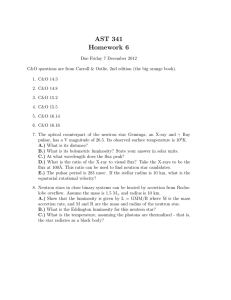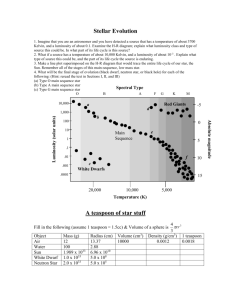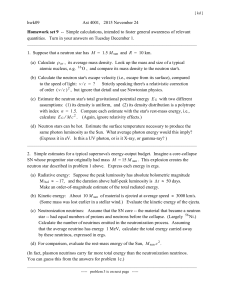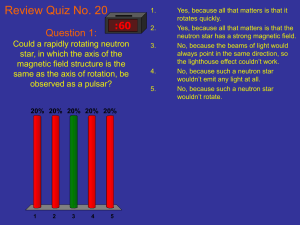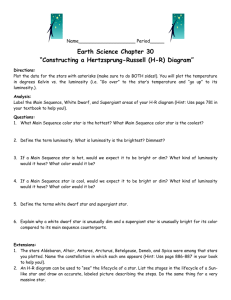Homework Sheet 2 - Questions & Answers
advertisement
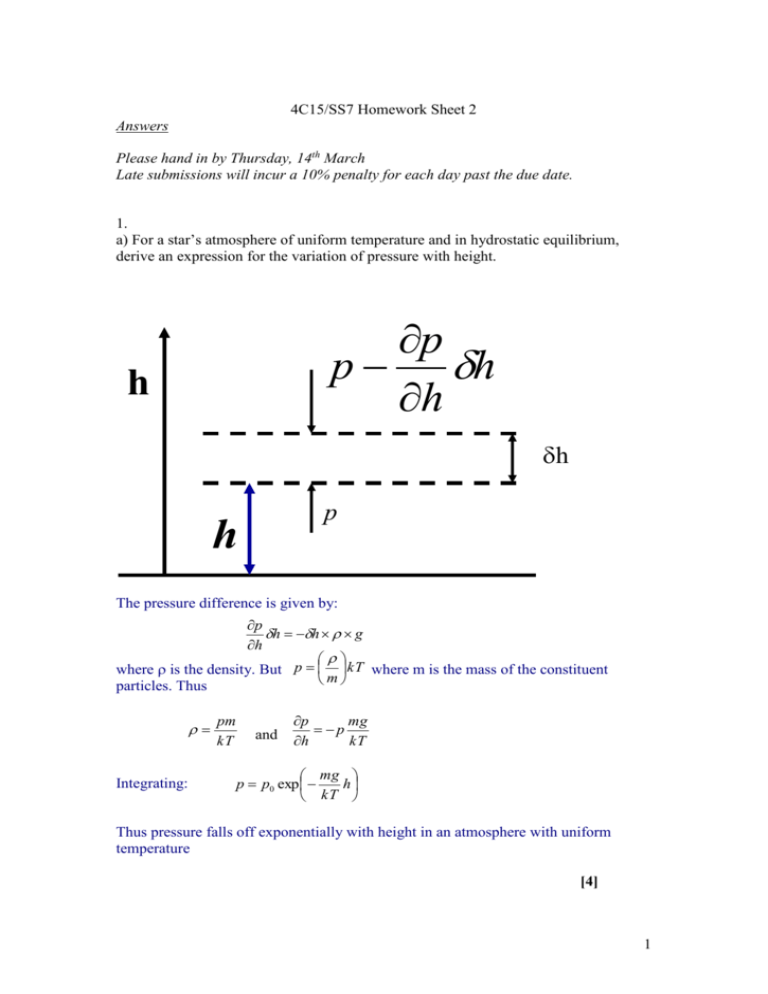
4C15/SS7 Homework Sheet 2 Answers Please hand in by Thursday, 14th March Late submissions will incur a 10% penalty for each day past the due date. 1. a) For a star’s atmosphere of uniform temperature and in hydrostatic equilibrium, derive an expression for the variation of pressure with height. p p h h h h p h The pressure difference is given by: p h h g h where is the density. But p kT where m is the mass of the constituent m particles. Thus Integrating: pm kT and p mg p h kT mg p p0 exp h kT Thus pressure falls off exponentially with height in an atmosphere with uniform temperature [4] 1 b) What is meant by the term “scale height”? kT has the dimensions of length and is called a “scale height”. h0 mg [1] c) Obtain the value of atmosphere scale height for a neutron star of mass 1M, radius 10 km and surface temperature 106 K. You may assume that the atmosphere is fully ionised and, for the purpose of the calculation, consists only of protons and electrons. [Boltzman’s constant, k = 1.38 x 10-23 J deg K-1; proton mass, mp = 1.67 x 10-27 kg] For a neutron star, g = 1012 m/s2 and T ~ 106 K. If hydrogen is the only constituent of the gas, then each proton and electron act as an independent particle of mass: (mp+me-)/2 ~ mp/2. Thus p = po exp (- mpgh/2kT) and ho = 2kT/mpg ~ 0.01m. [2] [7 marks] 2. a) For a spectral feature, of rest wavelengtho, generated in a thin layer of the atmosphere of a neutron star near its surface, write an expression for the gravitationally red-shifted wavelength of the feature. o (1 – 2GM/c2R)-1/2 [1] b) If o = 18.97 Å (O VIII Lyman ) is the rest wavelength of such a feature, what is the value of the gravitationally red-shifted wavelength in the case of a neutron star of mass 1.5 M and radius 10 km? = 18.97 (1 – 2 x 6.67.10-11 x 1.5 x 2.1030/9.1016 x 104)-1/2 = 18.97 x 1.342 = 25.46 Å [2] [3 marks] 3. a) If a 1 M neutron star of radius 10 km has an observed X-ray luminosity, LX = 1031 J/s, what is the mass accretion rate, in M/year, needed to sustain this luminosity? • Lacc = GMm/R • = 6.67.10-11 x 2.1030 x m/1.104 or • m = 1031/1016 = 1015 kg/s = 3.1022 kg/year = 10-8 M/year [3] 2 b) Calculate the accretion yields or efficiencies (in units of mc2 for the following 1 M objects – For M , G x M = 6.67.10-11 x 2.1030 = 1.33 x 1020 i. a neutron star R = 104 m, = 0.15 ii. a white dwarf R = 107 m, = 1.5 x 10-4 iii. the Sun R = 7.108 m, = 2.0 x 10-6 How do these compare with the typical value of for nuclear fusion? = 0.007 [3] c) Explain what is meant by the Eddington luminosity, LE, and derive an expression for its value. If L is the accretion luminosity, then the number of photons crossing unit area per sec at a distance r from the source is L 1 4r 2 h If the scattering cross-section is the Thomson cross-section, e, then the number of scatterings per second will be = L e 4r 2 h The momentum transferred from a photon to a particle is h/c and thus the momentum gained per second by the particles is the force exerted by photons on particles which is therefore L e h L e Newton = 2 4r h c 4r 2 c The source luminosity for which the radiation pressure balances the gravitational force on the accreting material is called the Eddngton luminosity and emerges from the equation L e Mm G 2 2 4r c r which gives LEdd 4cGMm e [2] 3 d) What are the values of LE, in J/s for – LEdd 4 3 108 6.67 10 11.1.67 10 27 6.65 10 29 x M J/s where m is taken as the proton mass since electrons and protons hold together through electrostatic forces i. a 1 M neutron star in a galactic binary system LEdd ~ 6.3 x M J/s = 1.3.1031 J/s ii. a 108 M black hole at the nucleus of an active galaxy LEdd ~ 6.3 x M J/s = 1.3.1039 J/s [2] [10 marks] 4
